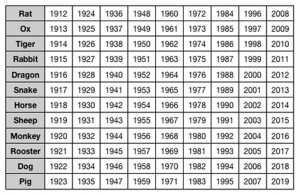Korean Lunar New Year: Traditions and Zodiac Animals Posted by Linda on Jan 19, 2012 in Culture, Grammar, Korean Language, Vocabulary
As the holiday season is quieting down in the Western world, the Eastern world is gearing up for Lunar New Year. Although Koreans celebrate both Solar and Lunar New Years, Lunar New Year is one of Korea’s most important traditional holidays. Traditional holidays are called 명절 (transliteration: “myeong jeol”). In our previous blog article, we discussed that Lunar New Year is called 설날 (transliteration: “Sohl-nahl”), with the literal meaning roughly translating to, “new day”.
설날 is a three-day public holiday in Korea; public holidays are called 공휴일 (transliteration: gonghyu- il). The holiday begins on 설날 eve; this year, 설날 lands on January 23rd. The 2012 three-day holiday will be from January 22nd to January 24th. Most Korean business are closed on 설날 eve and day, as most of Koreans travel to visit family members and elders. This is the busiest travel time of the year in Korea.
Will you celebrate 설날? If so, what are your plans? (Note: Next week, I will write about how I celebrated 설날!)
Many Korean businesses give 설날 calendars to their employees and customers; most of these calendars include both the solar and lunar cycles. Today, Korea abides by the solar calendar; but some traditionalists rely on the lunar calendar to determine birthdays, etc. In Korean, the (Gregorian) solar calendar is called 양력 (transliteration: “yang nyeok”), and the lunar calendar is called 음력 (transliteration: “eum nyeok”).
As 설날 approaches, Koreans enjoy festive décor donning the zodiac animal associated with the new year. This year, 2012, will be the year of the dragon; the fifth animal in the zodiac cycle. The dragon symbolizes courage, change, and hope! The 양력 has 12 zodiac animals; each animal represents a year, in a 12-year cycle.
The 12 zodiac animals in the 음력, in cyclic order:
Rat (쥐, jhi)
Ox (소, soh)
Tiger (호랑이, ho-rang-i)
Rabbit (토끼, toki)
Dragon (용, yong)
Snake (뱀, behm)
Horse (말, mahl)
Sheep (양, yang)
Monkey (원숭이, won-soong-i)
Rooster (수탉, soo-tahk)
Dog (개, gae)
Pig (돼지, deh-ji)
Most Koreans, when asking for your age, will ask you for your birth year. But, it can be fun to ask, “Which zodiac animal were you born under?” Here’s how to say it in Korean, “당신은 무엇 조디악 동물 아래에 태어 났죠?” (transliteration: “Dahngshi neun myo jodia dongmuhl nahdeh tay-oh nah-jho?”)
So, “당신은 무엇 조디악 동물 아래에 태어 났죠?”
Look at the chart below to determine your birth year’s zodiac animal. And remember, if you were born in January or February—you will have to reference the 음력 to see when 설날 began during your solar birth year. For example, if you were born on January 1st, 1990, you are a snake.
Many Koreans plan matchmaking, weddings, and childbirth around a particular zodiac animal year. The Year of the Dragon is supposedly a luck-filled year, especially for childbirth! If you would like to know more about the 2012 Dragon Year predictions, The Korea Blog explained it wonderfully, here: http://bit.ly/zc9IEO. I enjoyed reading about the symbolic significance of dragons in Buddhism, Korean culture, and Korean art!
I hope you have a wonderful Lunar New Year, and a prosperous Year of the Dragon! “Happy New Year!”/“새해 복 많이 받으세요!” (transliteration: “Say hey bok mahn ee bahd euh sae yo!”)

Build vocabulary, practice pronunciation, and more with Transparent Language Online. Available anytime, anywhere, on any device.





Comments:
krizzly:
I enjoyed reading about the symbolic significance of dragons in Buddhism, Korean culture, and Korean art!
Linda:
@krizzly Hi Krizzly, Thanks for your comment! 🙂
Juls Anne:
Traditions must be observed in order to preserved one’s culture.
Anna:
yes you are soooooooooooooooooooooooooooo right Juls .
David Milligan:
Thanks for this comprehensive website.I’ve known about the Chinese Zodiac for some time, but it was only in the last year as I got to know some Korean girls working in a nearby coffee shop that I learned about their version of the same Zodiac. One thing I find interesting is that two of the animals – at least 2 – have a generally bad connotation in Western culture. That would be the Rat and the Snake. We tend to perceive rats as vile disease-carrying animals and even use the derogatory term “rat” to denote a person who informs on others for their own advantage. The snake is often a symbol – going right back to Adam and Eve – of deceit. When I was young – an animal lover – my mother refused to let me bring a snake into our house, even though our local snakes were pretty harmless. One of my Korean friends born in the Year of the Rat may be aware of these stereotypes and calls herself rather “a Mouse”. And I am aware enough of more Eastern traditions to know that the snake can be a symbol of healing; witness the snake on the cadeucus that is still used as a symbol in the West of the medical profession. I’m a Dog (1958) and am quite happy to be one. Just some observations…ku ma wa…
Toneta:
hahahah i’m rooster 😀 this is soooo fun
Alex:
“당신은 무엇 조디악 동물 아래에 태어 났죠?” This is okay, but I’ve never heard anyone say it like that. In Korean, I think some people will understand you, but I think it’s better to say 띠 and not 조디악 동물. Normally, I’d ask 무슨 띠세요? or 무슨 띠예요?